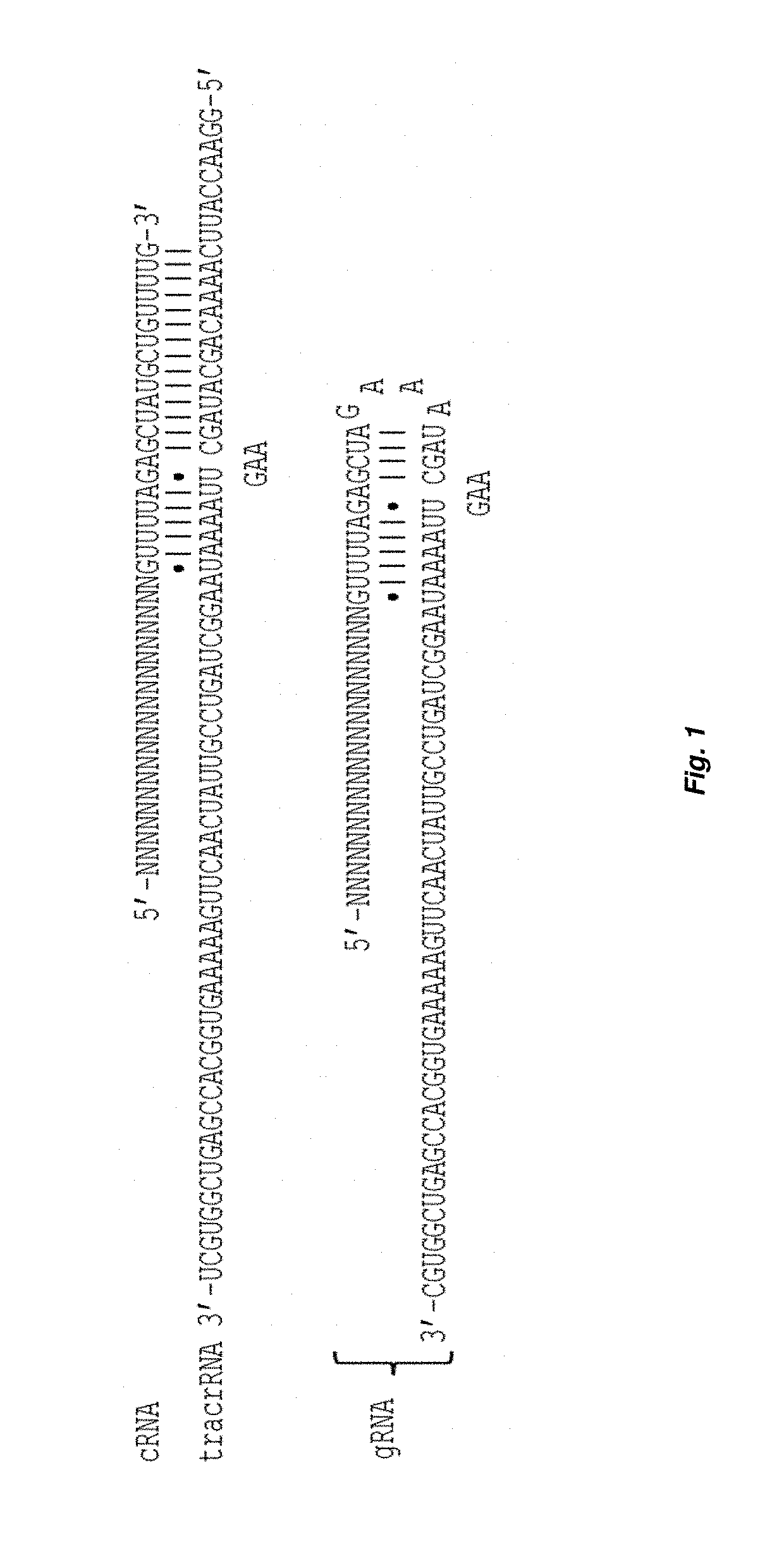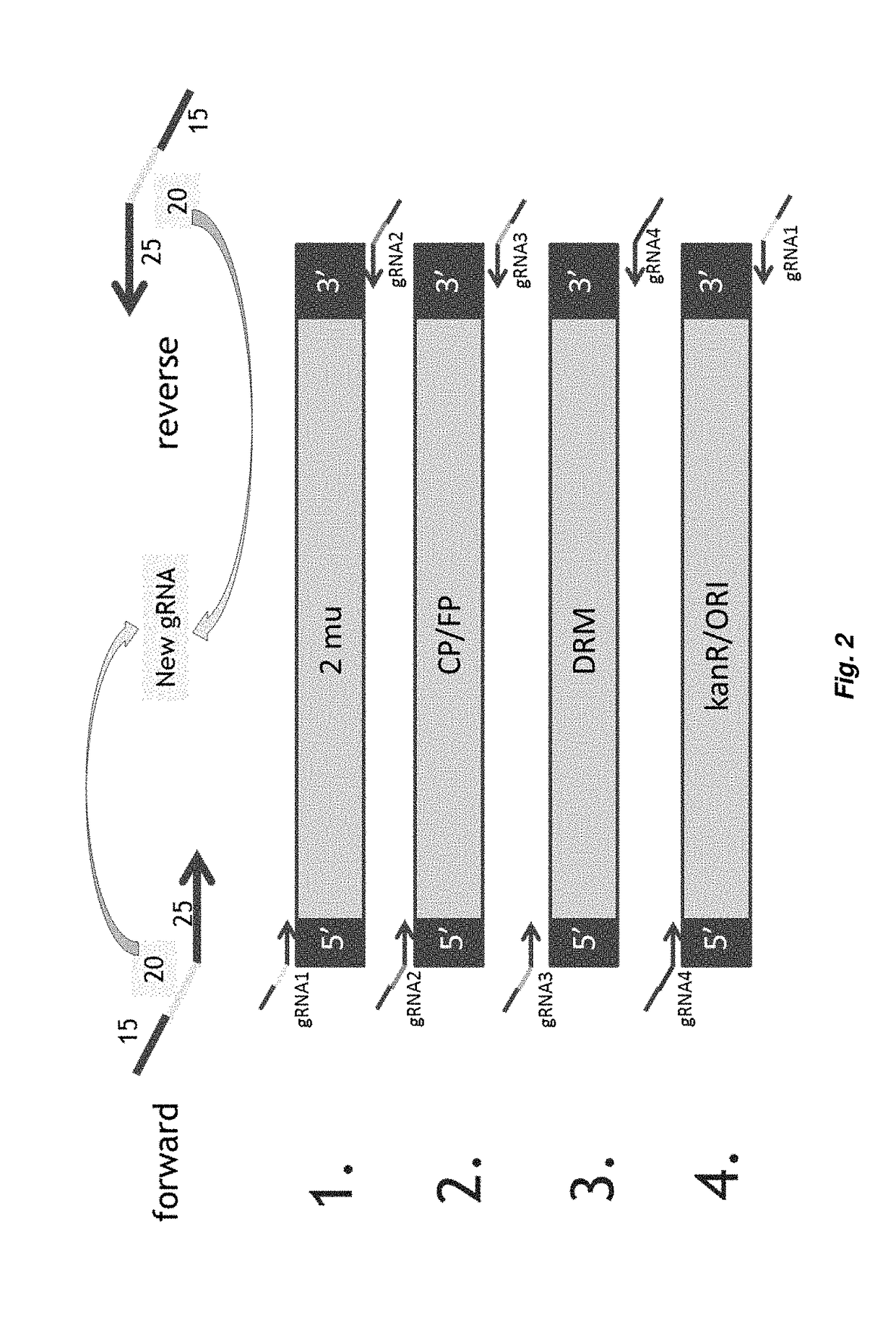Guide RNA assembly vector
- Summary
- Abstract
- Description
- Claims
- Application Information
AI Technical Summary
Benefits of technology
Problems solved by technology
Method used
Image
Examples
example 1
Construction of Cas9-Expressing Pentose-Fermenting Yeast Strain
[0576]For demonstration of S. cerevisiae strain modification using a CRISPR-Cas9 system including a vector according to the present invention, the genetically modified strain BIE272 (described in US20140141473) was used. This strain is able to ferment both hexose sugars (glucose, mannose, galactose) and pentose sugars (xylose and arabinose) because of the introduction of heterologous utilization pathways. Prior to the introduction of a 4gRNA self-assembling vector system according to the invention (see below), BIE272 was modified to express the Streptococcus pyogenes Cas9 protein (DiCarlo et al., 2013). The Cas9 expression cassette was integrated in combination with the natMX marker on an integration locus on chromosome 14. The complete sequence of the integration fragment including flanks to the integration locus, Cas9 expression cassette and the natMX marker is included in here as SEQ ID NO 2.
example 2
Description of the Standard Biobricks for 4gRNA-Vector Assembly in S. cerevisiae
[0577]For the expression of gRNA sequences into S. cerevisiae a gRNA expression cassette as previously described (DiCarlo et al., 2013) was used. The gRNA expression cassettes comprises the SNR52 promoter, the gRNA sequence consisting of the guide-sequence (crRNA; 20 nt) and the structural component, followed by the SUP4 terminator.
[0578]For the assembly of a episomally expressed plasmid in yeast there are certain elements which are required for the replication of the plasmid in yeast, or upon which selection can be exerted. The plasmid is assembled from 4 different polynucleotides (hereafter indicated as biobricks) each one corresponding to a polynucleotide consisting of a polynucleotide sequence to be extended in the overlap-extension PCR reaction described in Example 3.
[0579]Each biobrick is flanked:[0580]on the 5′-end terminus by a fragment of the guide RNA expression cassette corresponding to the s...
example 3
Using the 4gRNA Assembly System to Delete HXT Genes in BIE272
[0589]In this example the 4gRNA-vector assembly system was used to delete four hexose transporter gene clusters (HXT3-HXT6-HXT7 on chromosome IV, HXT5-HXT1-HXT4 on chromosome VIII, HXT2 on chromosome XIII, GAL2 on chromosome XII) in BIE272 rendering this pentose-fermenting strain unable to grow on pentose sugars since the pentose uptake capacity is eliminated with deletion of of the genes hxt1-hxt2-hxt3-hxt4-hxt5-hxt6-hxt7(indicated as hxt1-7 hereafter) and gal2 (Nijland et al., 2014). The gRNA sequences for HXT1 (to delete cluster HXT5-HXT1-HXT4 cluster), HXT2 (to delete HXT2), HXT3 (to delete cluster HXT3-HXT6-HXT7) and GAL2 (to delete GAL2) were selected on the DNA2.0 website (https: / www.dna20.come / eCommerce / cas9 / input). The guide sequences with score 100 were selected for implementation into the 4gRNA assembly system.
[0590]Extension of Biobricks with gRNA sequences targeting HXT genes by overlap extension PCR 20-bp pol...
PUM
| Property | Measurement | Unit |
|---|---|---|
| Fraction | aaaaa | aaaaa |
| Fraction | aaaaa | aaaaa |
| Fraction | aaaaa | aaaaa |
Abstract
Description
Claims
Application Information
 Login to View More
Login to View More - R&D
- Intellectual Property
- Life Sciences
- Materials
- Tech Scout
- Unparalleled Data Quality
- Higher Quality Content
- 60% Fewer Hallucinations
Browse by: Latest US Patents, China's latest patents, Technical Efficacy Thesaurus, Application Domain, Technology Topic, Popular Technical Reports.
© 2025 PatSnap. All rights reserved.Legal|Privacy policy|Modern Slavery Act Transparency Statement|Sitemap|About US| Contact US: help@patsnap.com



